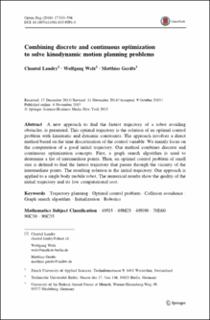Please use this identifier to cite or link to this item:
https://doi.org/10.21256/zhaw-29866Full metadata record
| DC Field | Value | Language |
|---|---|---|
| dc.contributor.author | Landry, Chantal | - |
| dc.contributor.author | Welz, Wolfgang | - |
| dc.contributor.author | Gerdts, Matthias | - |
| dc.date.accessioned | 2024-02-08T14:50:29Z | - |
| dc.date.available | 2024-02-08T14:50:29Z | - |
| dc.date.issued | 2016 | - |
| dc.identifier.issn | 1389-4420 | de_CH |
| dc.identifier.issn | 1573-2924 | de_CH |
| dc.identifier.uri | https://digitalcollection.zhaw.ch/handle/11475/29866 | - |
| dc.description | Erworben im Rahmen der Schweizer Nationallizenzen (http://www.nationallizenzen.ch) | de_CH |
| dc.description.abstract | A new approach to find the fastest trajectory of a robot avoiding obstacles, is presented. This optimal trajectory is the solution of an optimal control problem with kinematic and dynamic constraints. The approach involves a direct method based on the time discretization of the control variable. We mainly focus on the computation of a good initial trajectory. Our method combines discrete and continuous optimization concepts. First, a graph search algorithm is used to determine a list of intermediate points. Then, an optimal control problem of small size is defined to find the fastest trajectory that passes through the vicinity of the intermediate points. The resulting solution is the initial trajectory. Our approach is applied to a single body mobile robot. The numerical results show the quality of the initial trajectory and its low computational cost. | de_CH |
| dc.language.iso | en | de_CH |
| dc.publisher | Springer | de_CH |
| dc.relation.ispartof | Optimization and Engineering | de_CH |
| dc.rights | Licence according to publishing contract | de_CH |
| dc.subject | Trajectory planning | de_CH |
| dc.subject | Optimal control problem | de_CH |
| dc.subject | Collision avoidance | de_CH |
| dc.subject | Graph search algorithm | de_CH |
| dc.subject | Initialization | de_CH |
| dc.subject | Robotics | de_CH |
| dc.subject.ddc | 621.3: Elektro-, Kommunikations-, Steuerungs- und Regelungstechnik | de_CH |
| dc.title | Combining discrete and continuous optimization to solve kinodynamic motion planning problems | de_CH |
| dc.type | Beitrag in wissenschaftlicher Zeitschrift | de_CH |
| dcterms.type | Text | de_CH |
| zhaw.departement | School of Engineering | de_CH |
| zhaw.organisationalunit | Institut für Angewandte Mathematik und Physik (IAMP) | de_CH |
| dc.identifier.doi | 10.1007/s11081-015-9291-0 | de_CH |
| dc.identifier.doi | 10.21256/zhaw-29866 | - |
| zhaw.funding.eu | No | de_CH |
| zhaw.issue | 3 | de_CH |
| zhaw.originated.zhaw | Yes | de_CH |
| zhaw.pages.end | 556 | de_CH |
| zhaw.pages.start | 533 | de_CH |
| zhaw.publication.status | publishedVersion | de_CH |
| zhaw.volume | 17 | de_CH |
| zhaw.publication.review | Peer review (Publikation) | de_CH |
| zhaw.author.additional | No | de_CH |
| zhaw.display.portrait | Yes | de_CH |
| Appears in collections: | Publikationen School of Engineering | |
Files in This Item:
| File | Description | Size | Format | |
|---|---|---|---|---|
| 2016_Landry-etal_Optimization-kinodynamic-motion-planning-problems.pdf | 721.59 kB | Adobe PDF |  View/Open |
Show simple item record
Landry, C., Welz, W., & Gerdts, M. (2016). Combining discrete and continuous optimization to solve kinodynamic motion planning problems. Optimization and Engineering, 17(3), 533–556. https://doi.org/10.1007/s11081-015-9291-0
Landry, C., Welz, W. and Gerdts, M. (2016) ‘Combining discrete and continuous optimization to solve kinodynamic motion planning problems’, Optimization and Engineering, 17(3), pp. 533–556. Available at: https://doi.org/10.1007/s11081-015-9291-0.
C. Landry, W. Welz, and M. Gerdts, “Combining discrete and continuous optimization to solve kinodynamic motion planning problems,” Optimization and Engineering, vol. 17, no. 3, pp. 533–556, 2016, doi: 10.1007/s11081-015-9291-0.
LANDRY, Chantal, Wolfgang WELZ und Matthias GERDTS, 2016. Combining discrete and continuous optimization to solve kinodynamic motion planning problems. Optimization and Engineering. 2016. Bd. 17, Nr. 3, S. 533–556. DOI 10.1007/s11081-015-9291-0
Landry, Chantal, Wolfgang Welz, and Matthias Gerdts. 2016. “Combining Discrete and Continuous Optimization to Solve Kinodynamic Motion Planning Problems.” Optimization and Engineering 17 (3): 533–56. https://doi.org/10.1007/s11081-015-9291-0.
Landry, Chantal, et al. “Combining Discrete and Continuous Optimization to Solve Kinodynamic Motion Planning Problems.” Optimization and Engineering, vol. 17, no. 3, 2016, pp. 533–56, https://doi.org/10.1007/s11081-015-9291-0.
Items in DSpace are protected by copyright, with all rights reserved, unless otherwise indicated.